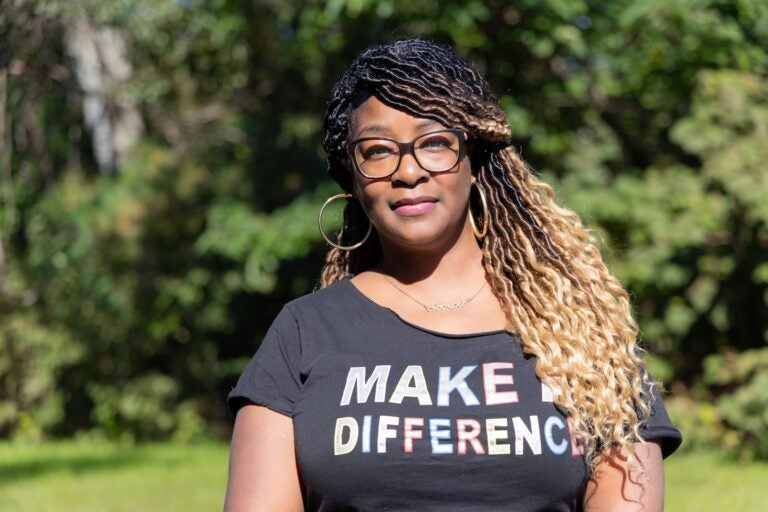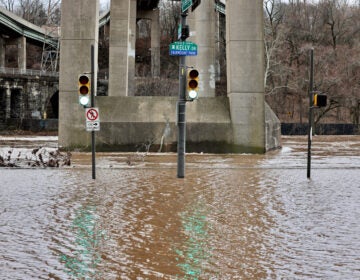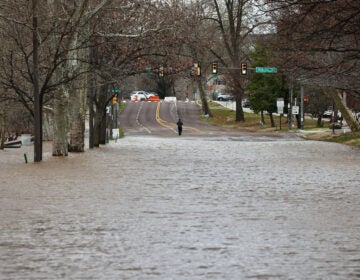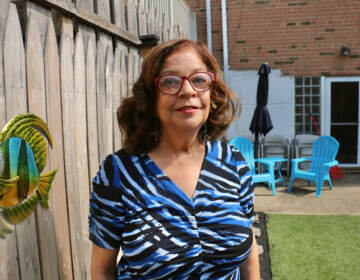Philadelphians are missing out on flood insurance discounts. The city could cash in next year
Climate change will bring increased flooding to the Philly region, but flood insurance can be a hardship for many homeowners. A FEMA program could help lower the cost.
Listen 4:02
Jamie Glenn outside her home in Philadelphia's Eastwick neighborhood. (Kimberly Paynter/WHYY)
This story is part of the WHYY News Climate Desk, bringing you news and solutions for our changing region.
From the Poconos to the Jersey Shore to the mouth of the Delaware Bay, what do you want to know about climate change? What would you like us to cover? Get in touch.
Jamie Glenn loves many things about her neighborhood in Southwest Philly: the open space, the family-oriented atmosphere, and most of all, the neighbors who support one another, especially during hard times. One thing she does not like about her neighborhood is the fact that it floods. And that, she says, comes with unexpected costs.
In 2020, Tropical Storm Isaias sent several feet of water gushing into Eastwick homes, including Glenn’s two-story brick rowhouse. The flood destroyed everything in her finished basement, including her drywall, washer and dryer, hot water heater, HVAC system, a full set of living room furniture and old family photos.
Glenn first found out about the flood risk in her neighborhood eight years earlier, when she sat down to sign the mortgage on the home — her first — with her mom by her side. One of the mortgage lenders mentioned that flood insurance would be required, because the house is in a federally designated high-risk flood zone.
“Flood insurance, what do you mean?” Glenn remembers saying. “It would be nice to know that on the front end. … You’re blindsided.”
It was a cost she hadn’t accounted for, especially as a single mother of a young teenager at the time. She now pays over $1,900 per year for flood insurance.
“Being a single mom, every penny is accounted for,” she said. “So when you get there, and they tell you now it’s more money, it’s like, oh my God, OK. I wasn’t bracing for that.”
Flood insurance is increasingly important for homeowners, as human-caused climate change increases flood risk throughout the region. But it can be a financial burden, costing households hundreds or thousands of dollars per year.
There is a way for homeowners like Glenn to get discounts of up to 45% on their federal flood insurance, through a Federal Emergency Management Agency program called the Community Rating System. But municipalities must opt in.
Baltimore residents receive a 25% discount on their insurance premiums as a result of the program. In New Jersey, Ocean City, Atlantic City and Cape May residents receive discounts between 20% and 30%.
More than two dozen towns in Pennsylvania participate, but the city of Philadelphia where Glenn lives — the municipality with the most federal flood insurance policies in the state — is not one of them.
A decade after the city first started looking into the program, Philadelphia officials say they’re still “actively exploring the potential of joining” FEMA’s Community Rating System. But they estimate the earliest the city could enter the program is 2025.
“It’s not that there’s no passion behind it, there’s no momentum,” Elaine Montes, program manager for flood resilience and compliance strategy in the city’s Office of Sustainability, told WHYY News last fall. “We’re pulling the pieces together, but it is a slow process.”
Flood insurance can be a hardship
Over 3,400 residential properties in Philadelphia are covered by flood insurance policies through the National Flood Insurance Program, which provides most flood insurance nationwide. For single-family homes, including rowhouses, the median annual cost is currently $870, according to FEMA.
Some homeowners, like Anita Barnes, pay much more.
Barnes first moved to Eastwick more than two decades ago as a renter. She lost a car during Hurricane Floyd in 1999, but thought the flood was a fluke.
“I heard … ‘Oh, you don’t have to worry about it. This is like a once-in-a-lifetime occurrence,’” she said.
So Barnes was surprised to learn she needed flood insurance when she bought the home she’d been renting in 2015. Her yearly flood insurance premium was $625 at the time, but since then, the cost has gone up. She switched providers after her agent sent her a quote for over $12,300 in 2021, after she filed a claim when her home flooded during Isaias. She now pays just under $2,000 per year for a policy administered by a private carrier through the National Flood Insurance Program.
“The cost, I think, is very expensive,” Barnes said. “You always have to [think], what other things can I eliminate to cover this cost?”
The cost of flood insurance — which is typically not included in homeowners insurance — recently changed for many homeowners across the country, as FEMA recalibrated its flood insurance rates to more accurately reflect flood risk and the cost of rebuilding flooded homes.
Most policyholders in Philly saw their premiums stay flat or increase by up to $120 in the first year, according to FEMA data. Premiums went down for more than a quarter of Philly policyholders, including many in Eastwick, a predominantly African American neighborhood where flooding is just one of several environmental concerns.

The new pricing system corrects for nationwide inequities that previously meant owners of higher-value homes underpaid for flood insurance while owners of lower-value homes overpaid, FEMA said. But a 2023 Government Accountability Office analysis of the new rating system estimated that federal flood insurance will continue to cost a higher percentage of household income for Black or African American households compared to white, Hispanic or Latino, and Asian households nationwide.
Flood insurance is not required for every home exposed to flooding. Homeowners living just outside the FEMA floodplain or those without a mortgage — often older homeowners or those living in generational homes — don’t need to buy it. For people living on fixed incomes or with lots of other expenses, flood insurance may fall lower on the list of priorities. But if a flood hits, the lack of insurance can be devastating.
Nelson Haakenson, a semi-retired painting contractor, small landlord and father of three, did not have flood insurance when the remnants of Hurricane Ida swept through the Philly region in 2021. The Schuylkill River rose and filled the basement of his East Falls rowhouse with 6 feet of water, cracking his chimney, destroying his hot water heaters and ruining musical instruments and family photos. After the incident, which cost his family thousands of dollars, Haakenson realized he should have flood insurance, even though his home is just outside the FEMA high-risk zone.
“I know that I’m walking on eggshells by not having coverage,” he said. “I can … almost see the river from here, so it’s a little scary.”
Nearly three years after the storm, Haakenson is still rolling the dice. He’s compared several flood insurance policies, including on the private market, but hasn’t purchased one. He said he has other priorities he needs to spend that money on — including paying off the mortgage on his home, supporting family overseas and saving to replace his aging car.
“It would be a hardship — let’s just put it that way,” he said. “I’d either have to work more, or I’d have to find a way to economize.”
Flood insurance discounts of up to 45%
FEMA’s Community Rating System offers flood insurance discounts proportional to the measures a municipality takes to reduce the risk of flood damage.
Participating local governments earn points for flood-safe policies and practices, such as guaranteeing that open space in the floodplain won’t be developed, limiting the amount of fill used to raise parcels in the floodplain or requiring the first floor of new buildings be built above minimum levels. Municipalities can also earn points for activities including buying out flood-prone buildings, sending early flood warnings to the public and keeping digital copies of property data.
The more points a community receives, the deeper the discount for residents. Discounts range from 5% to 45%, in increments of 5%.
Most Pennsylvania, New Jersey and Delaware municipalities that participate in the program earn their residents discounts between 10% and 20%. Very few municipalities nationwide earn the deepest discounts, above 30%.
Philly’s path to joining FEMA’s CRS
City officials expect Philly would likely enter the Community Rating System at a level that would give residents a 10% discount on FEMA flood insurance. The city could pursue a discount of 20% “with dedicated staff support” and would likely need to hire the equivalent of one additional staff member to administer the program regardless of the discount level, said Dora Chi, program coordinator for communications and strategic initiatives in the city’s Office of Sustainability, in a written statement.
Officials say the city could earn points for things it already does: its public communication around flood risk, its requirement that the first floors of new buildings in the 100-year floodplain be elevated 1.5 feet above the level that flood is expected to reach, its ban on hospitals and correctional facilities in the floodplain, its restrictions on development on steep slopes and its hazard mitigation plan.
In order to get more points, however, the city may need to take some unpopular steps. For example, it could restrict the use of fill in the floodplain, raise elevation standards for new construction even higher or fully prohibit new buildings in a floodplain.
It would be hard for the city to gain points for buying out or relocating properties, because of the physical constraints of attached rowhouses, Montes said.
It would likely be difficult for the city to secure discounts that would meaningfully help Glenn, Barnes and Haakenson. But the three homeowners want to see the city go after more aggressive discounts, like the 35% off that Avalon, New Jersey residents enjoy.
“A discount is better than nothing, but I feel that it needs to be more than 10%,” Barnes said.
Haakenson, who still considers getting flood insurance, said a discount of 20% would be a bigger motivator.
“If it was more like 35%, 40% — I think then that would definitely push me towards making that kind of purchase,” he said.

Streamlining the process for flood insurance discounts
A report published last week by a Pennsylvania task force on flood insurance affordability recommends the state help municipalities participate in the Community Rating System.
“Right now, we don’t have nearly enough communities participating,” Pennsylvania insurance commissioner Michael Humphreys, who chaired the task force, told WHYY News in May.
Philly’s experience of trying to join the program reflects what Humphreys has heard from several municipalities: the process can be time- and resource-intensive.
“Even though many communities have already implemented qualifying mitigation tactics, … residents are precluded from obtaining flood insurance premium discounts because their community is not formally enrolled in the CRS program,” the task force’s report reads.
Philly started looking into joining the Community Rating System roughly a decade ago, Montes said. But it took the city years to fully resolve floodplain management issues FEMA flagged during a 2016 audit required to join the program. FEMA said last fall that the delays on formally resolving those issues were due to staffing changes at the state and federal level, as well as the COVID-19 shutdown.
The Pennsylvania task force recommended the creation of a statewide Office of Community Rating System Assistance to streamline the process. The office, which would likely be located within the state’s emergency management agency, would help municipalities implement activities that would earn them points, help them apply and educate non-CRS communities about the program.
“We can talk to communities about what’s worked, what hasn’t worked in other communities,” Humphreys said before the task force report was published. “And hopefully really speed the preparation time and serve as a resource to be able to build the technical expertise.”
Montes sees Philly’s participation in the Community Rating System and the resulting flood insurance discounts as part of the city’s adaptations to climate change.
“If anything, we need it more now than ever,” she said last fall. “And we will need it more in the future.”

Subscribe to PlanPhilly
WHYY is your source for fact-based, in-depth journalism and information. As a nonprofit organization, we rely on financial support from readers like you. Please give today.












